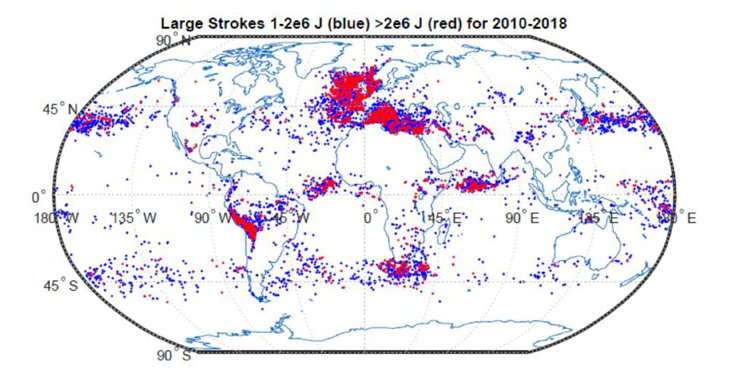Hotspots found for lightning’s superbolts
New map highlights where to find the most intense lightning strikes

This striking array of lightning is zapping the open Mediterranean, a superbolt hotspot.
Jurkos/iStock /Getty Images Plus
Not every lightning strike is the same. Some skip from cloud to cloud. Others strike the ground, delivering a shocking wallop to anything that gets in the way. Lightning differs by how strong it is, too. Scientists have observed mega-strikes of lightning that carry 1,000 times more energy than ordinary bolts. They’re so intense that, about four decades ago, a scientist had to coin a new word to describe them: Superbolts!
Scientists don’t yet know how these mega-bolts amass so much energy. But they don’t strike equally everywhere, a new study finds.
Superbolts seem to strike mostly at sea, it finds. And they don’t occur at the same rate throughout the year. Few, for instance, develop from April to October.
Bob Holzworth is an atmospheric physicist at the University of Washington in Seattle. He recently led a study to determine where superbolts tend to occur. And what his team found surprised them. “There were some very interesting peculiarities,” notes Holzworth.
Superbolts can strike almost anywhere. However, the largest number hit the northern hemisphere during winter.

The mega-strikes develop most often over the North Atlantic Ocean and the Mediterranean Sea. The Andes Mountains, in South America, had more superbolt strikes than other nearby areas. Another broad band of superbolt activity stretches across the Northern Pacific Ocean, east of Japan.
The mega-zaps show uncommon patterns
“The biggest surprise to me is the high-latitude regions, such as the North Atlantic,” says Ningyu Liu. Although he was not involved with this study, this atmospheric scientist studies extreme lightning at the University of New Hampshire in Durham. “We know that in tropical and subtropical regions, lightning activity is frequent,” Liu says. “But for superbolts, it looks totally different.”
What surprised Holzworth most was finding that some eight in every 10 superbolts each year strike over the open ocean. Previous surveys have recorded lightning striking mostly over land. But when scientists restricted their focus to the super intense strikes, another pattern emerged. Clearly, says Holzworth, “Lightning strikes over the oceans have more energy than those over land.” Why? “We don’t know.”
Holzworth leads the World Wide Lightning Location Network (WWLLN). It includes more than 80 sensors across the globe. For this new study, he and his team analyzed WWLLN data on 2 billion superbolts of lightning. All struck between 2010 and 2018.
WWLLN sensors pick up radio waves that are produced when lightning strikes. These long wavelengths are a form of electromagnetic radiation. The network’s sensors sit thousands of miles from each other. Yet they can still detect the same waves. That’s because radio waves from lightning can travel long distances without changing. For their study, Holzworth and his team studied only strikes detected by at least five separate sensors. That helped them pinpoint where the strikes hit.
WWLLN watches lightning from the ground. At the same time, satellites can detect lightning from above. “There’s a huge difference between what we see from above the clouds and what we see in the radio waves on the surface,” says Holzworth. Satellites detect visible flashes of light, which means they don’t catch strikes hidden behind or beneath clouds. But radio waves can travel long distances without being blocked. “Radio doesn’t care about the clouds,” Holzworth says. When he studied satellite data, he was able to find flashes that corresponded to some of the superbolts picked up by WWLLN.
Future studies might show not only where superbolts form but also how they become so powerful. Lightning strikes when negative charge builds up in the clouds and finds a path downward through the air. (It often meets an upward-reaching path for positive charges, called a streamer.) By using other types of sensors, Holzworth says, scientists could trace the paths of individual bolts.
In that way, Liu adds, “We could get some very detailed [measurements] of individual superbolts.”







